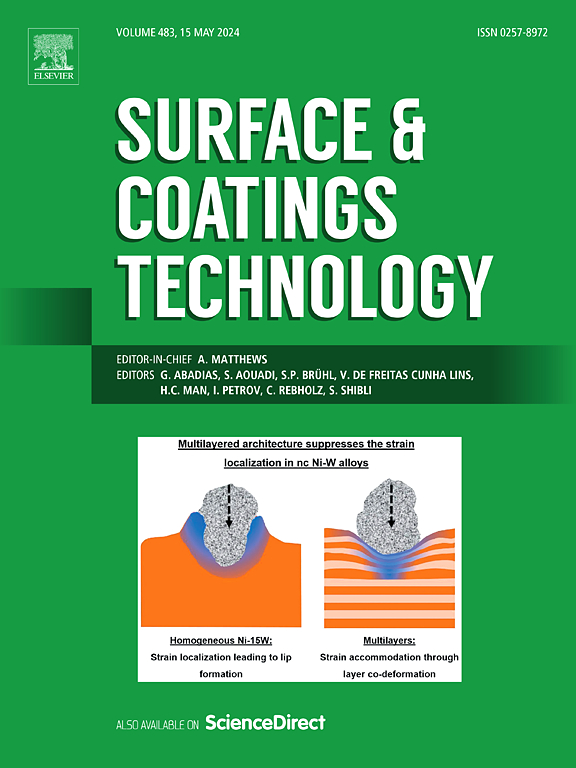Pt/Ru对PtRu覆层改性MCrAlYTa涂层氧化机理的影响
IF 5.3
2区 材料科学
Q1 MATERIALS SCIENCE, COATINGS & FILMS
引用次数: 0
摘要
本研究探讨了不同Pt/Ru比例对电沉积真空退火PtRu覆层NiCoCrAlYTa涂层氧化机理的影响。采用重量变化测量、扫描电镜/能谱分析(SEM/EDS)、x射线衍射(XRD)和x射线光电子能谱(XPS)进行高温氧化分析,结果表明Pt含量越高,抗氧化性能越好。这是由于在热生长氧化物(TGO)层中产生了更致密、更薄、更均匀的氧化铝(α-Al2O3)层。相反,Ru含量的增加会导致TGO层中其他氧化物和微裂纹随着氧化铝的发展而发展,从而破坏氧化保护。随着Pt含量的增加,以最小变质形式存在的Ti和Ta与Y一起进入氧化石墨烯层,进一步增强了抗氧化性。除了探索了Pt/Ru比对氧化物结垢特性和抗氧化性的显著影响外,与Pt相比,Ru的成本更低,这表明通过优化Pt/Ru比和微结构工程设计具有成本效益的系统的潜力。本文章由计算机程序翻译,如有差异,请以英文原文为准。
Influence of Pt/Ru ratios on the oxidation mechanism of MCrAlYTa coatings modified with PtRu overlays
This study investigates the influence of varying Pt/Ru ratios on the oxidation mechanism of NiCoCrAlYTa coatings with electrodeposited, vacuum-annealed Pt![]() Ru overlays. Weight change measurements, scanning electron microscopy/energy dispersive X-ray spectrometry (SEM/EDS), X-ray diffraction (XRD), and X-ray photoelectron spectroscopy (XPS) were used for high-temperature oxidation analyses, showing superior resistance with higher Pt contents. This was attributed to the creation of a denser, thinner, and more homogeneous layer of alumina (α-Al2O3) in the thermally-grown oxide (TGO) layer. On the contrary, an increase in Ru contents led to the development of other oxides and microcracks along with alumina in the TGO layer, undermining oxidation protection. The accommodation of Ti and Ta, in the minimally-deteriorative form of carbide, along with Y into the TGO layer with increasing Pt contents further enhanced oxidation resistance. In addition to the explored significant impact of the Pt/Ru ratio on oxide scale characteristics and oxidation resistance, the lower cost of Ru compared to Pt suggests the potential for designing cost-effective systems through optimized Pt/Ru ratios and microstructural engineering.
Ru overlays. Weight change measurements, scanning electron microscopy/energy dispersive X-ray spectrometry (SEM/EDS), X-ray diffraction (XRD), and X-ray photoelectron spectroscopy (XPS) were used for high-temperature oxidation analyses, showing superior resistance with higher Pt contents. This was attributed to the creation of a denser, thinner, and more homogeneous layer of alumina (α-Al2O3) in the thermally-grown oxide (TGO) layer. On the contrary, an increase in Ru contents led to the development of other oxides and microcracks along with alumina in the TGO layer, undermining oxidation protection. The accommodation of Ti and Ta, in the minimally-deteriorative form of carbide, along with Y into the TGO layer with increasing Pt contents further enhanced oxidation resistance. In addition to the explored significant impact of the Pt/Ru ratio on oxide scale characteristics and oxidation resistance, the lower cost of Ru compared to Pt suggests the potential for designing cost-effective systems through optimized Pt/Ru ratios and microstructural engineering.
求助全文
通过发布文献求助,成功后即可免费获取论文全文。
去求助
来源期刊

Surface & Coatings Technology
工程技术-材料科学:膜
CiteScore
10.00
自引率
11.10%
发文量
921
审稿时长
19 days
期刊介绍:
Surface and Coatings Technology is an international archival journal publishing scientific papers on significant developments in surface and interface engineering to modify and improve the surface properties of materials for protection in demanding contact conditions or aggressive environments, or for enhanced functional performance. Contributions range from original scientific articles concerned with fundamental and applied aspects of research or direct applications of metallic, inorganic, organic and composite coatings, to invited reviews of current technology in specific areas. Papers submitted to this journal are expected to be in line with the following aspects in processes, and properties/performance:
A. Processes: Physical and chemical vapour deposition techniques, thermal and plasma spraying, surface modification by directed energy techniques such as ion, electron and laser beams, thermo-chemical treatment, wet chemical and electrochemical processes such as plating, sol-gel coating, anodization, plasma electrolytic oxidation, etc., but excluding painting.
B. Properties/performance: friction performance, wear resistance (e.g., abrasion, erosion, fretting, etc), corrosion and oxidation resistance, thermal protection, diffusion resistance, hydrophilicity/hydrophobicity, and properties relevant to smart materials behaviour and enhanced multifunctional performance for environmental, energy and medical applications, but excluding device aspects.
 求助内容:
求助内容: 应助结果提醒方式:
应助结果提醒方式:


